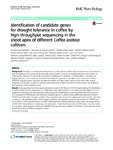Please use this identifier to cite or link to this item:
http://www.alice.cnptia.embrapa.br/alice/handle/doc/1043710| Title: | Identification of candidate genes for drought tolerance in coffee by high-throughput sequencing in the shoot apex of different Coffea arabica cultivars. |
| Authors: | MOFATTO, L. S.  CARNEIRO, F. de A.   VIEIRA, N. G.   DUARTE, K. E.   VIDAL, R. O.   ALEKCEVETCH, J. C.   COTTA, M. G.   VERDEIL, J-L.   LAPEYRE-MONTES, F.   LARTAUD, M.   LEROY, T.   DE BELLIS, F.   POT, D   RODRIGUES, G. C.   CARAZZOLLE, M. F.   PEREIRA, G. A. G.   ANDRADE, A. C.   MARRACCINI, P.   |
| Affiliation: | LUCIANA OLIVEIRA VIDAL, CENARGEN; FERNANDA DE ARAÚJO CARNEIRO, CENARGEN; NATALIA GOMES VIEIRA; KAROLINE ESTEFANI DUARTE; RAMON OLIVEIRA VIDAL; JEAN CAROS ALEKCEVETCH, CENARGEN; MICHELLE GUITTON COTTA, CENARGEN; JEAN-LUC VERDEIL, CIRAD/UMR/AGAP; FABIENNE LEPEYRE-MONTES, CIRAD/UMR/AGAP; MARC LARTAUD, CIRAD/UMR/AGAP; THIERRY LEROY, CIRAD/UMR/AGAP; FABIEN DE BELLIS, CIRAD/UMR/AGAP; DVID POT, CIRAD/UMR/AGAP; GUSTAVO COSTA RODRIGUES, CNPTIA; MARCELO FALSARELLA CARAZZOLLE; GONÇALO AMARANTE GUIMARÃES PEREIRA; ALAN CARVALHO ANDRADE, SAPC; PIERRE MARRACCINI. |
| Date Issued: | 2016 |
| Citation: | BMC Plant Biology, v. 16, n. 94, 2016. |
| Description: | BACKGROUND: Drought is a widespread limiting factor in coffee plants. It affects plant development, fruit production, bean development and consequently beverage quality. Genetic diversity for drought tolerance exists within the coffee genus. However, the molecular mechanisms underlying the adaptation of coffee plants to drought are largely unknown. In this study, we compared the molecular responses to drought in two commercial cultivars (IAPAR59, drought-tolerant and Rubi, drought-susceptible) of Coffea arabica grown in the field under control (irrigation) and drought conditions using the pyrosequencing of RNA extracted from shoot apices and analysing the expression of 38 candidate genes. RESULTS: Pyrosequencing from shoot apices generated a total of 34.7 Mbp and 535,544 reads enabling the identification of 43,087 clusters (41,512 contigs and 1,575 singletons). These data included 17,719 clusters (16,238 contigs and 1,575 singletons) exclusively from 454 sequencing reads, along with 25,368 hybrid clusters assembled with 454 sequences. The comparison of DNA libraries identified new candidate genes (n = 20) presenting differential expression between IAPAR59 and Rubi and/or drought conditions. Their expression was monitored in plagiotropic buds, together with those of other (n = 18) candidates genes. Under drought conditions, up-regulated expression was observed in IAPAR59 but not in Rubi for CaSTK1 (protein kinase), CaSAMT1 (SAM-dependent methyltransferase), CaSLP1 (plant development) and CaMAS1 (ABA biosynthesis). Interestingly, the expression of lipid-transfer protein (nsLTP) genes was also highly up-regulated under drought conditions in IAPAR59. This may have been related to the thicker cuticle observed on the abaxial leaf surface in IAPAR59 compared to Rubi. CONCLUSIONS: The full transcriptome assembly of C. arabica, followed by functional annotation, enabled us to identify differentially expressed genes related to drought conditions. Using these data, candidate genes were selected and their differential expression profiles were confirmed by qPCR experiments in plagiotropic buds of IAPAR59 and Rubi under drought conditions. As regards the genes up-regulated under drought conditions, specifically in the drought-tolerant IAPAR59, several corresponded to orphan genes but also to genes coding proteins involved in signal transduction pathways, as well as ABA and lipid metabolism, for example. The identification of these genes should help advance our understanding of the genetic determinism of drought tolerance in coffee. |
| Thesagro: | Coffea Arábica |
| NAL Thesaurus: | Drought |
| Keywords: | Candidate gene Coffee Differential gene expression RNA-Seq Real-time PCR (RT-qPCR) |
| Type of Material: | Artigo de periódico |
| Access: | openAccess |
| Appears in Collections: | Artigo em periódico indexado (SAPC)  |
Files in This Item:
| File | Description | Size | Format | |
|---|---|---|---|---|
| Identificationofcandidategenes.pdf | 3,78 MB | Adobe PDF |  View/Open |









